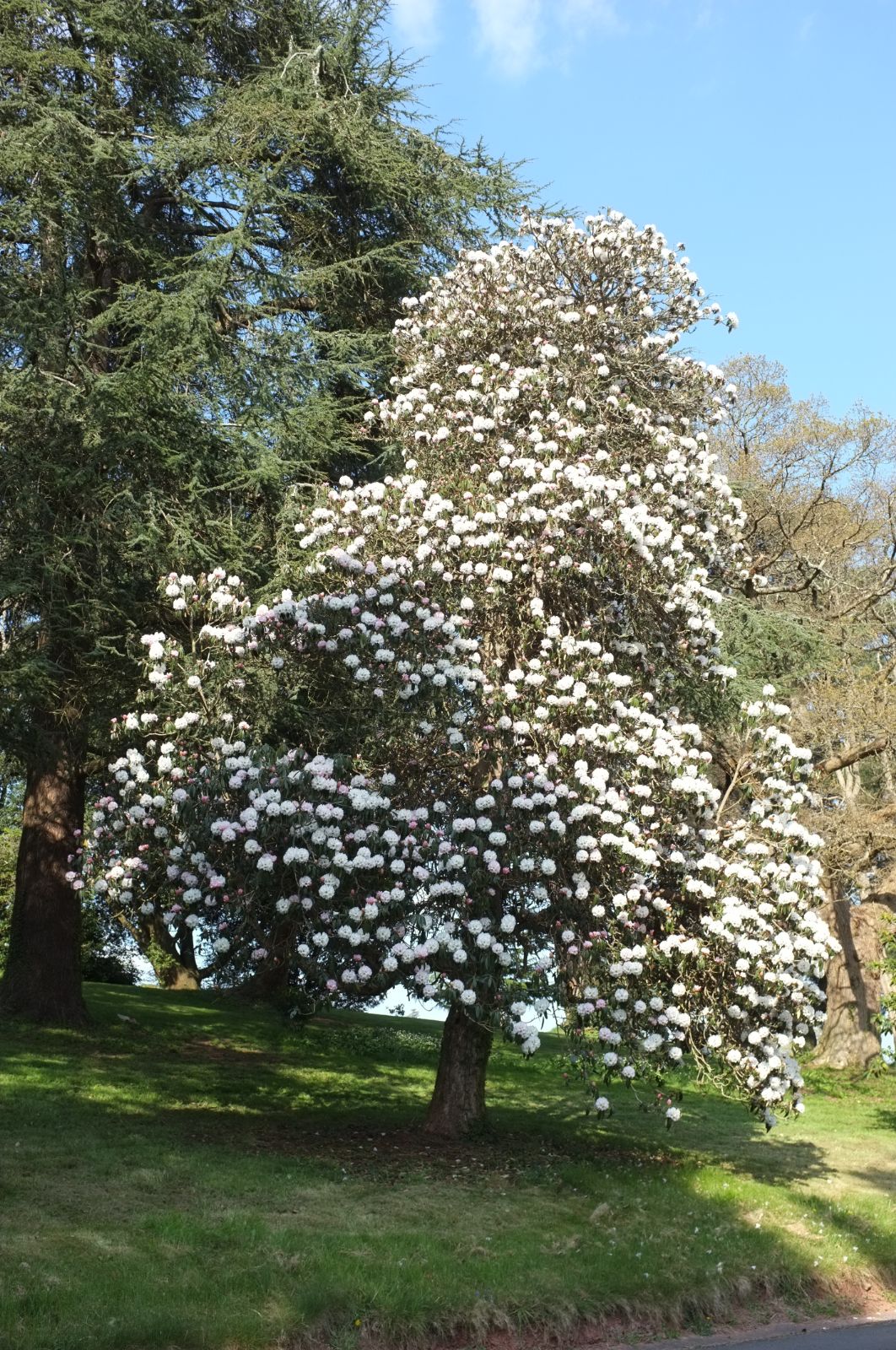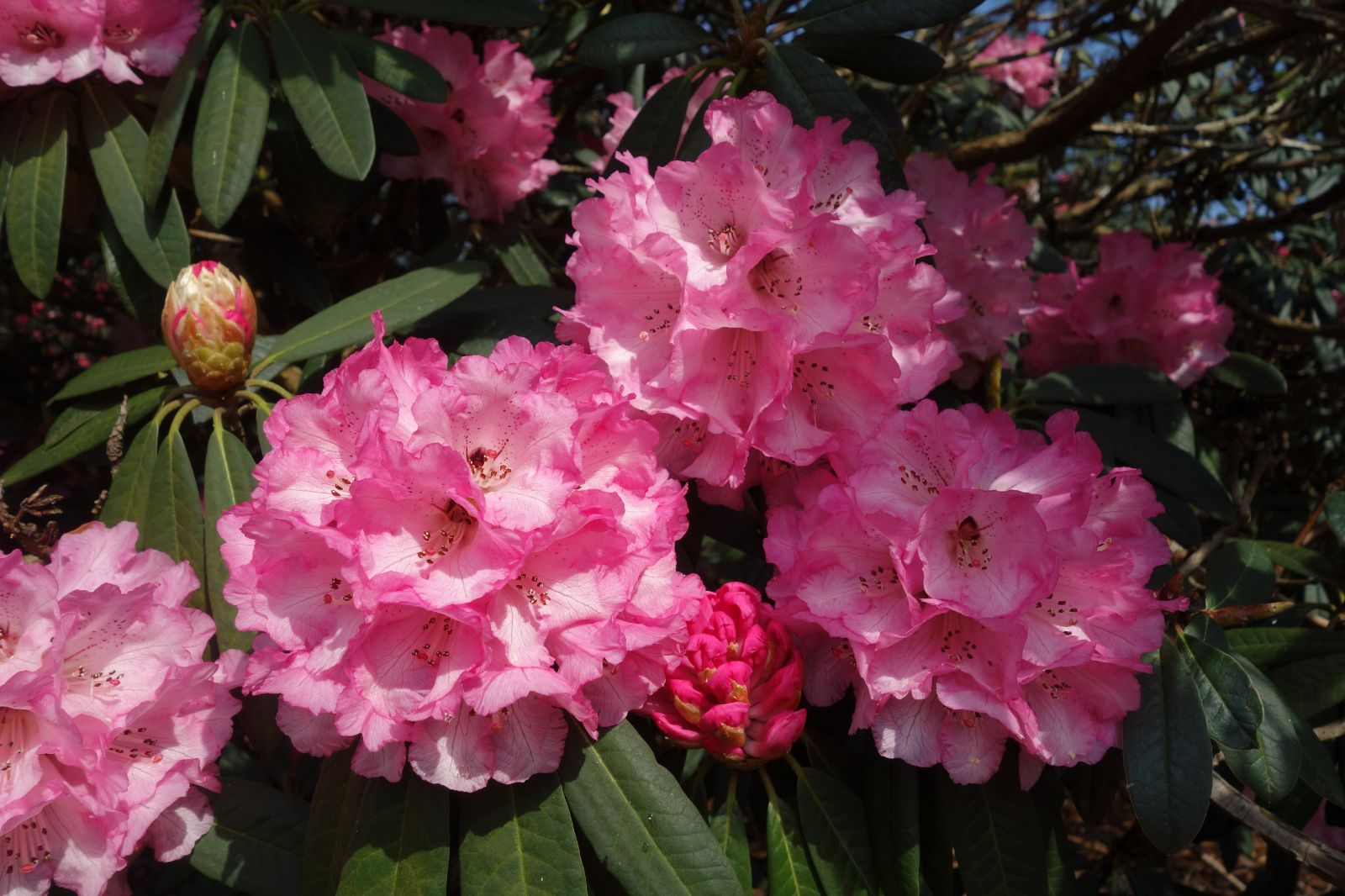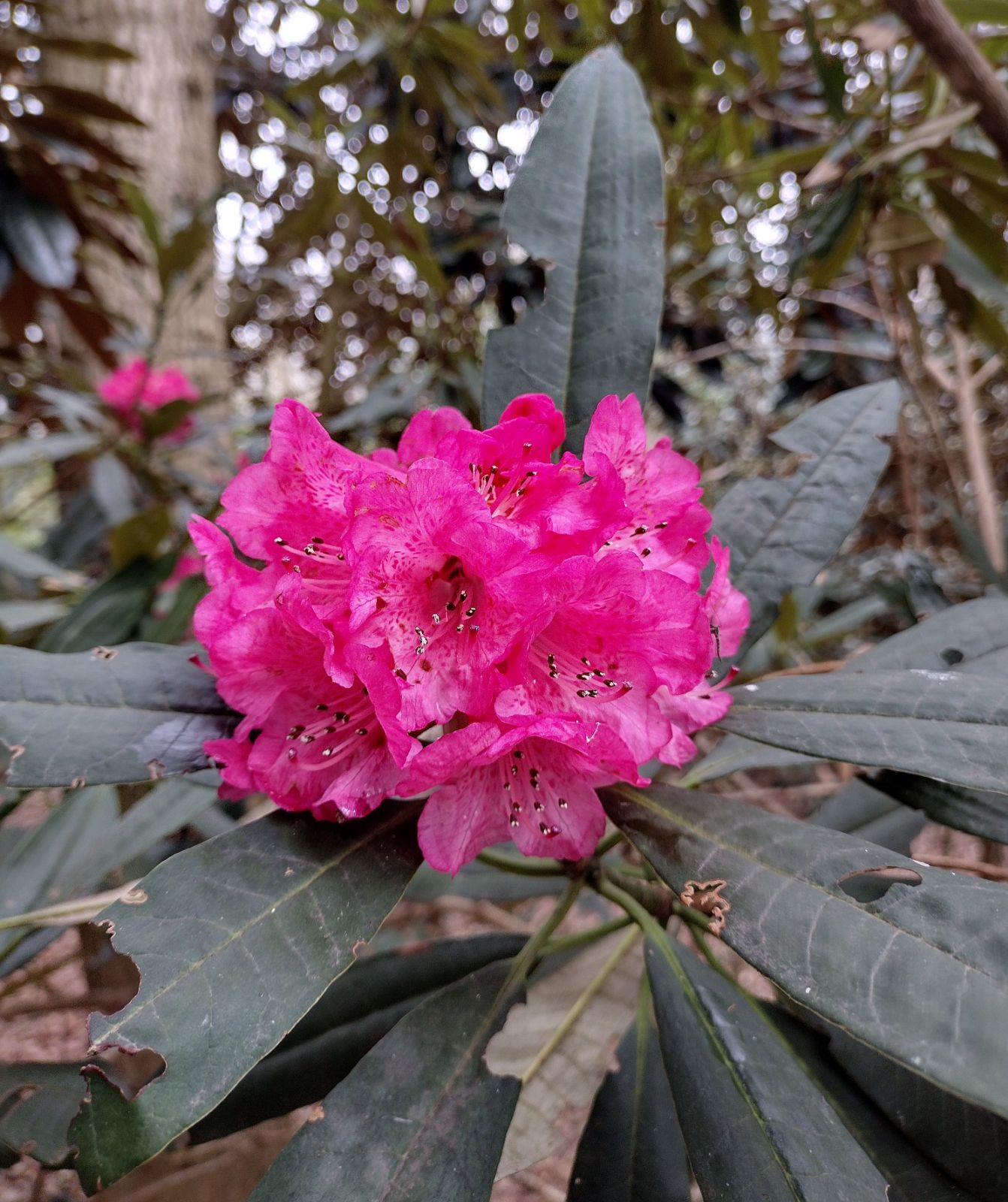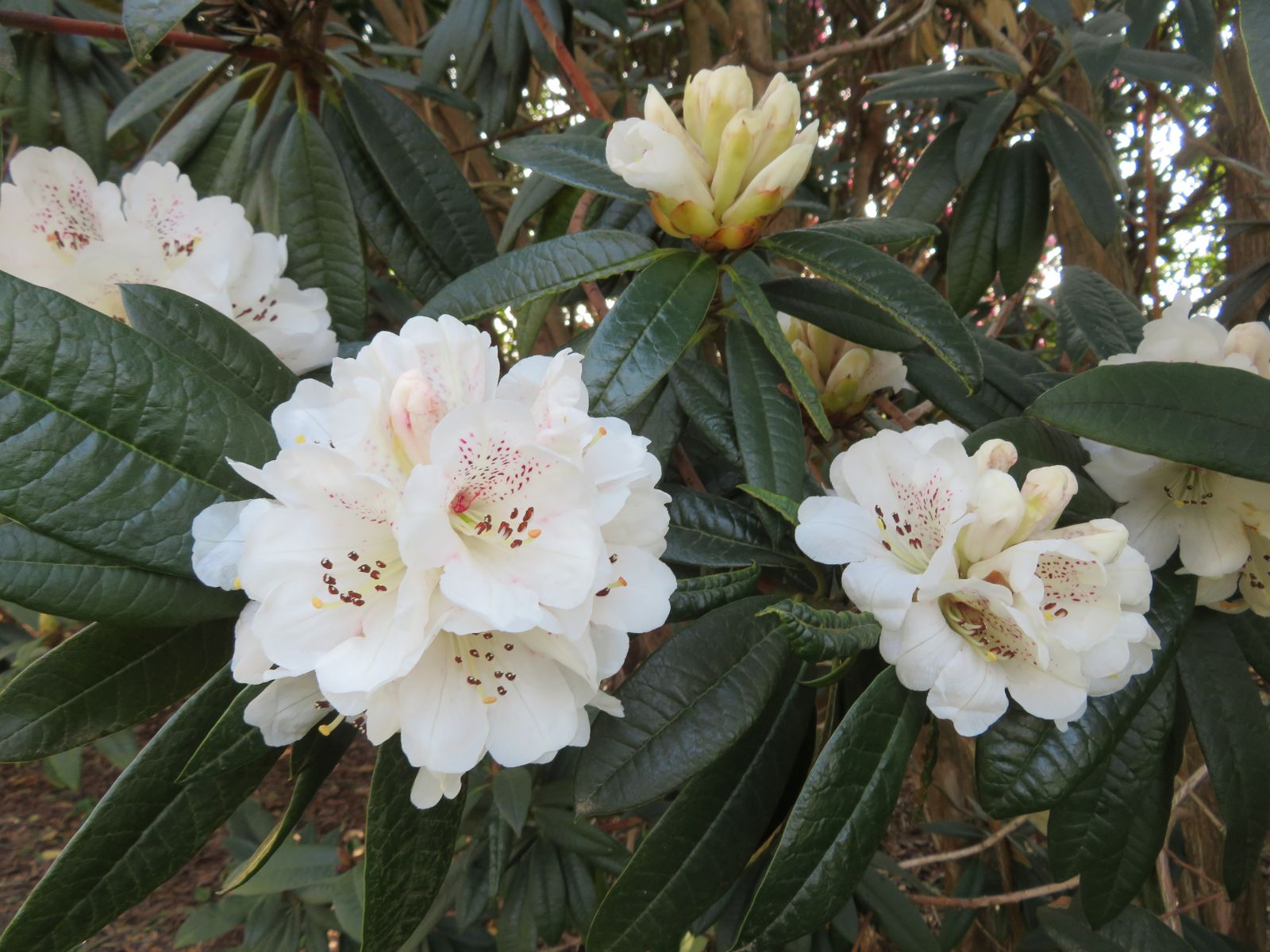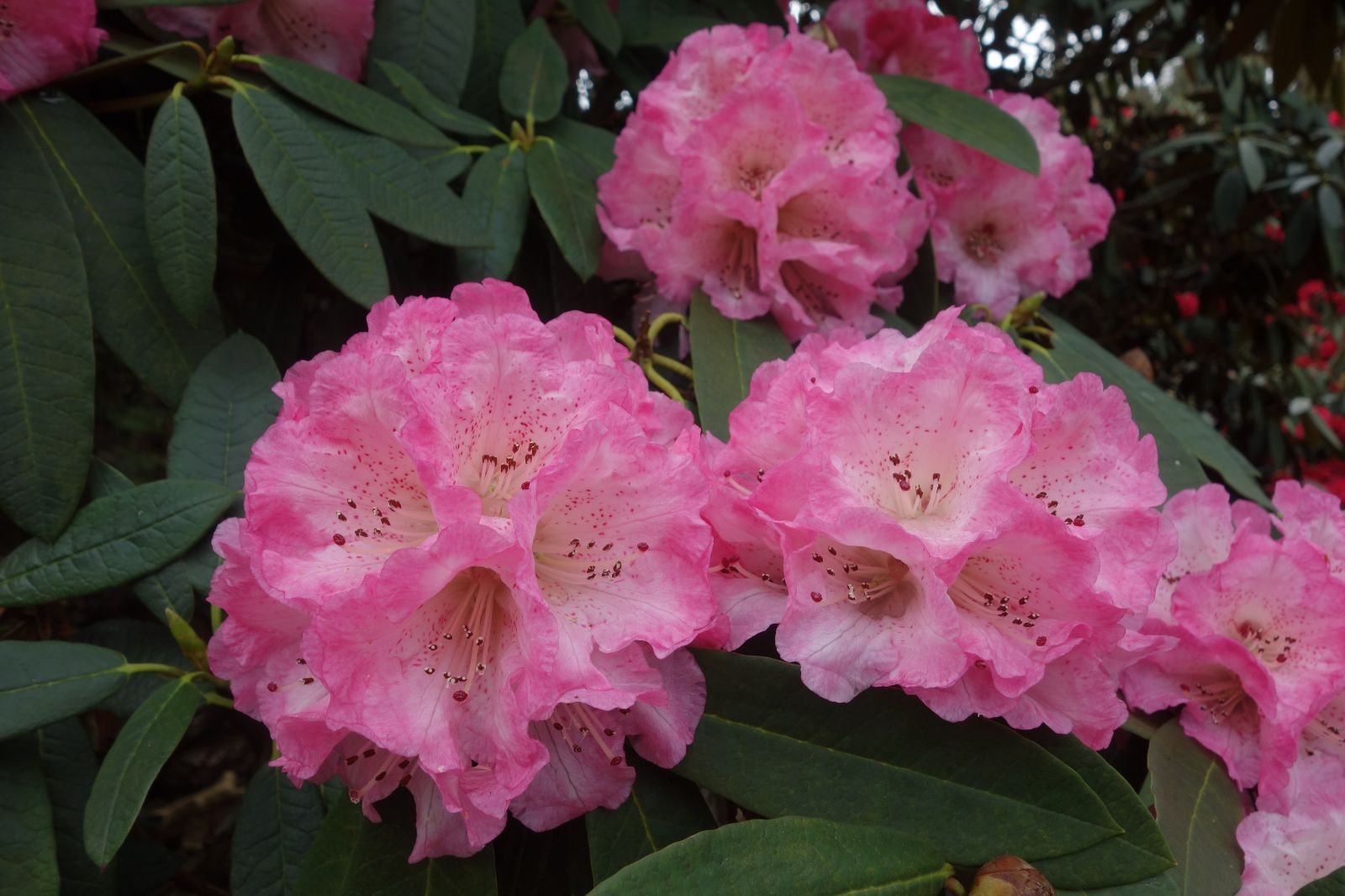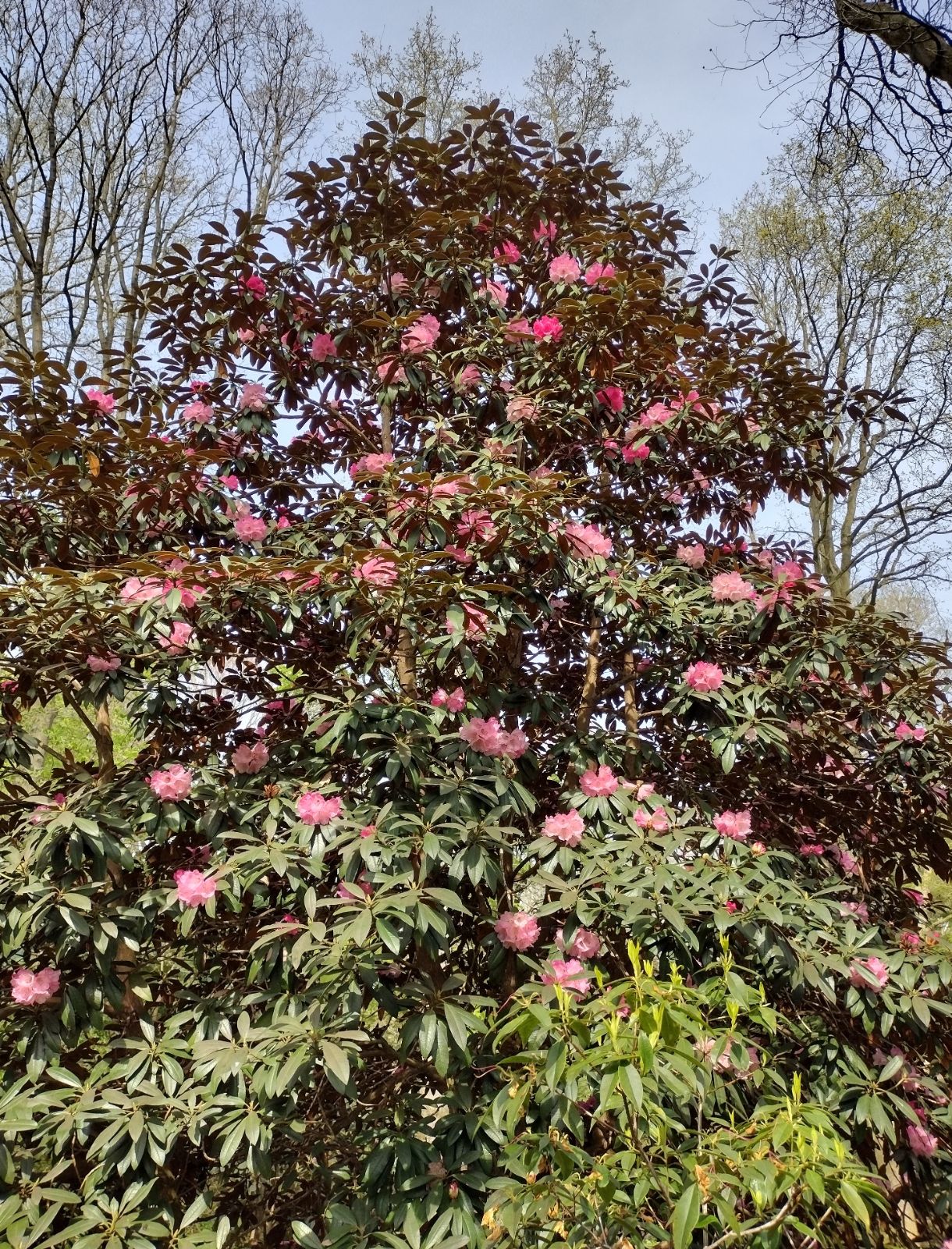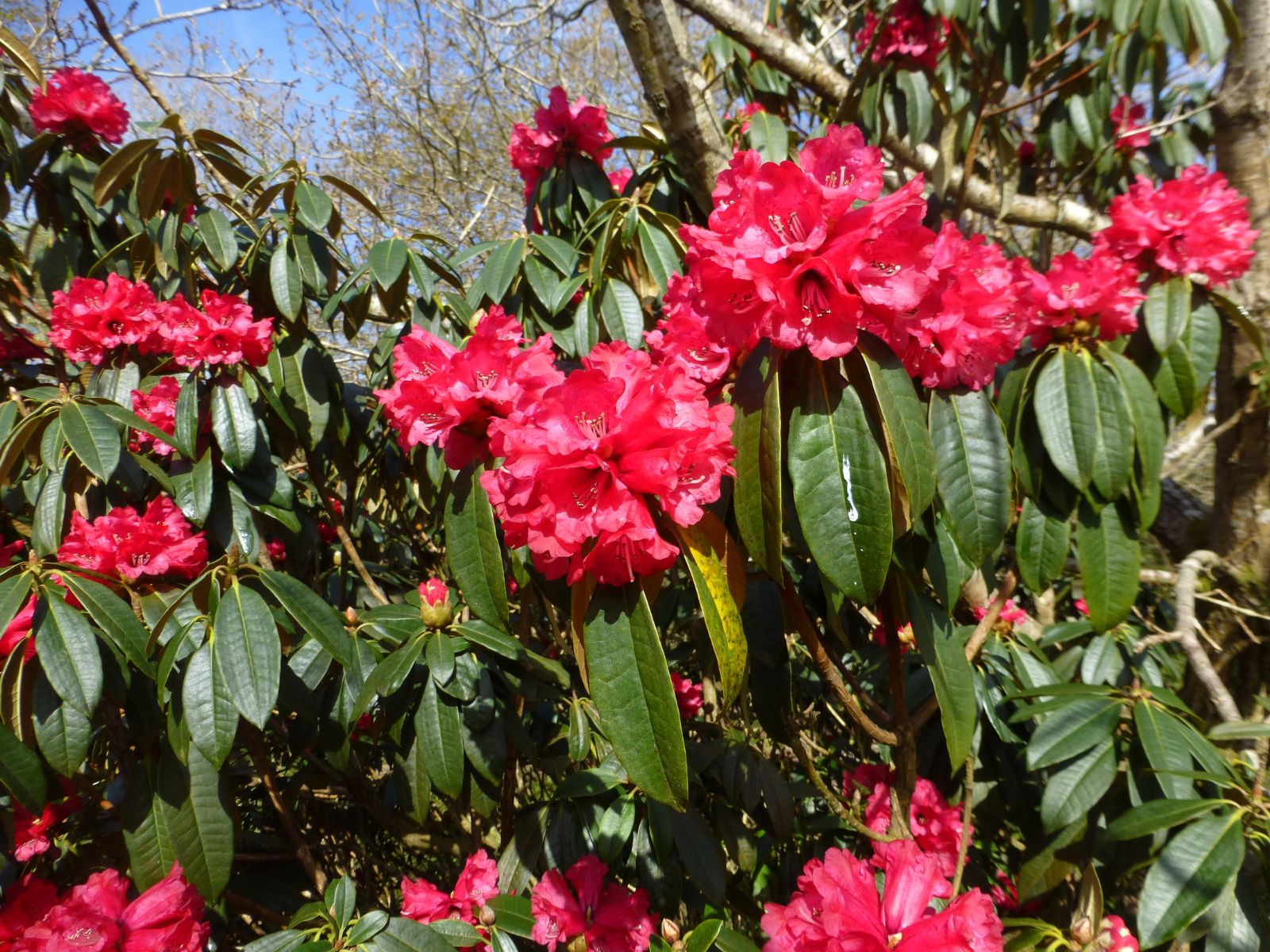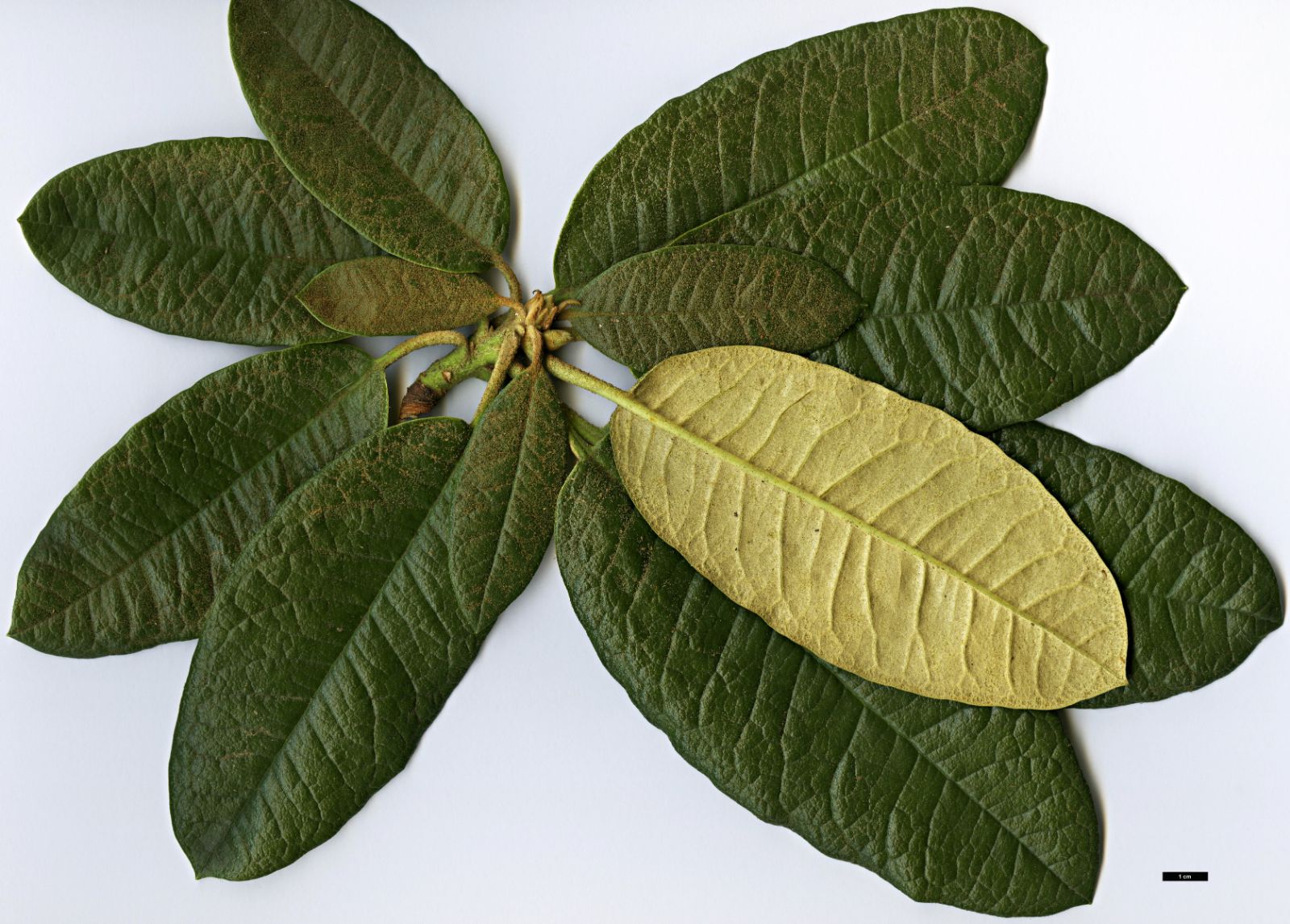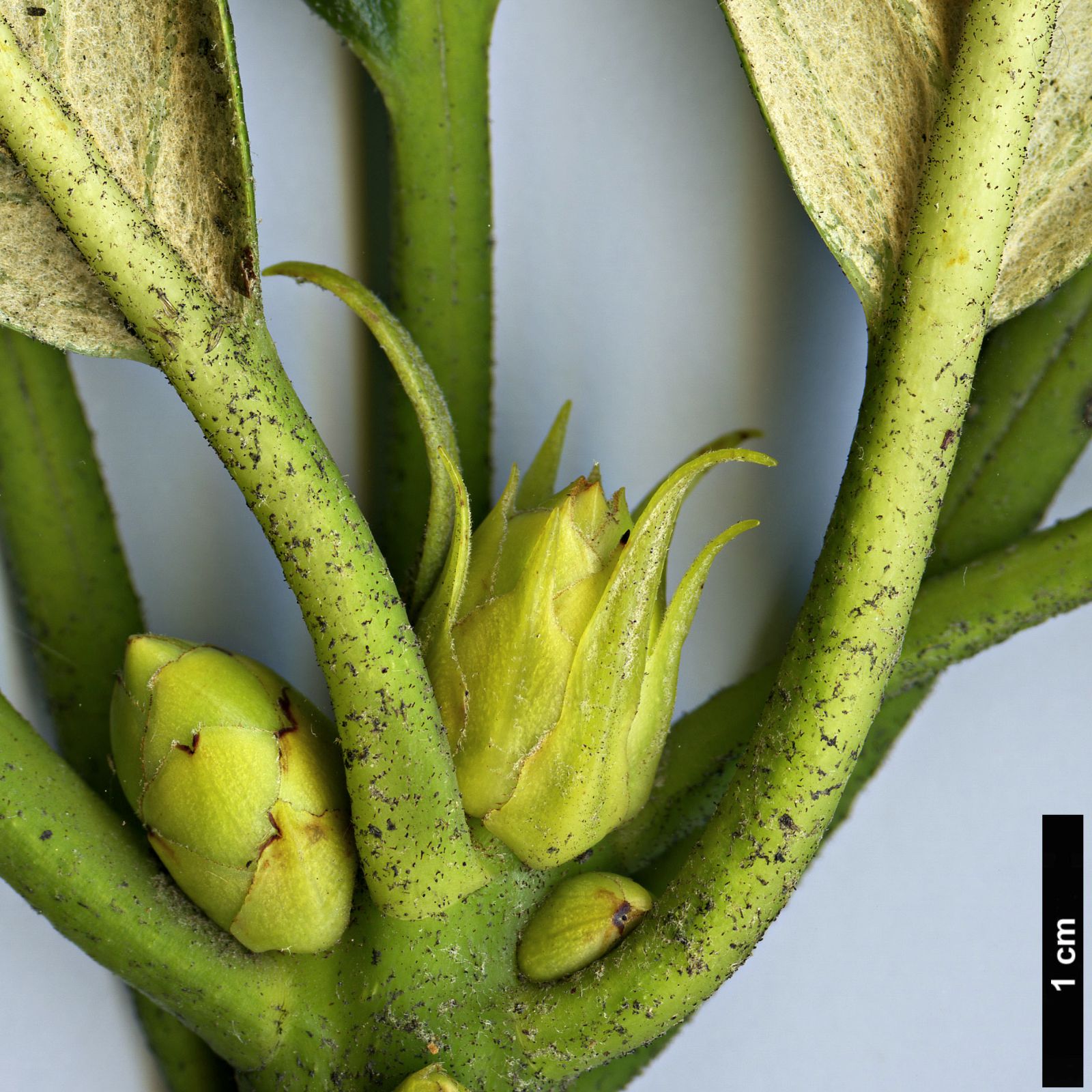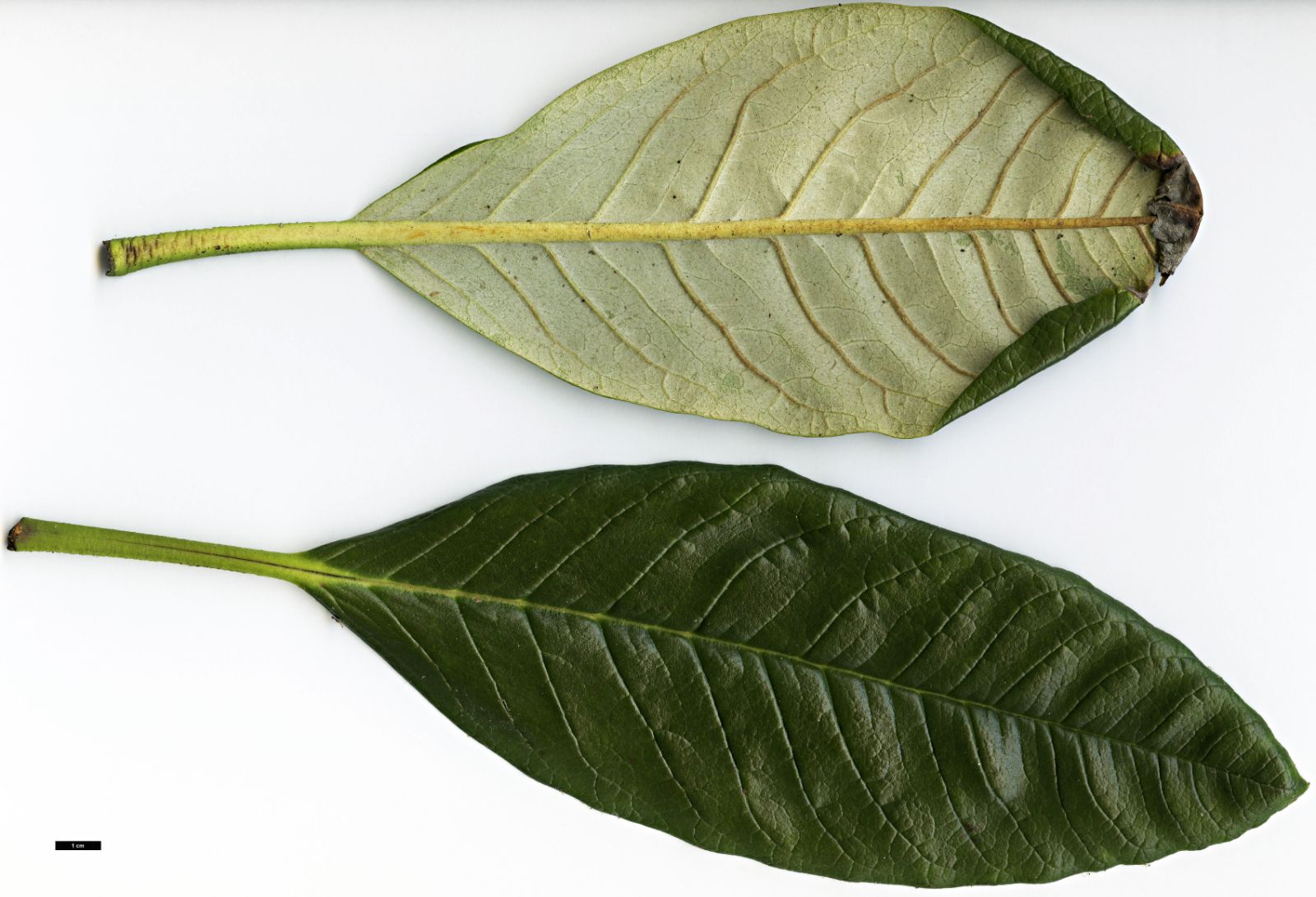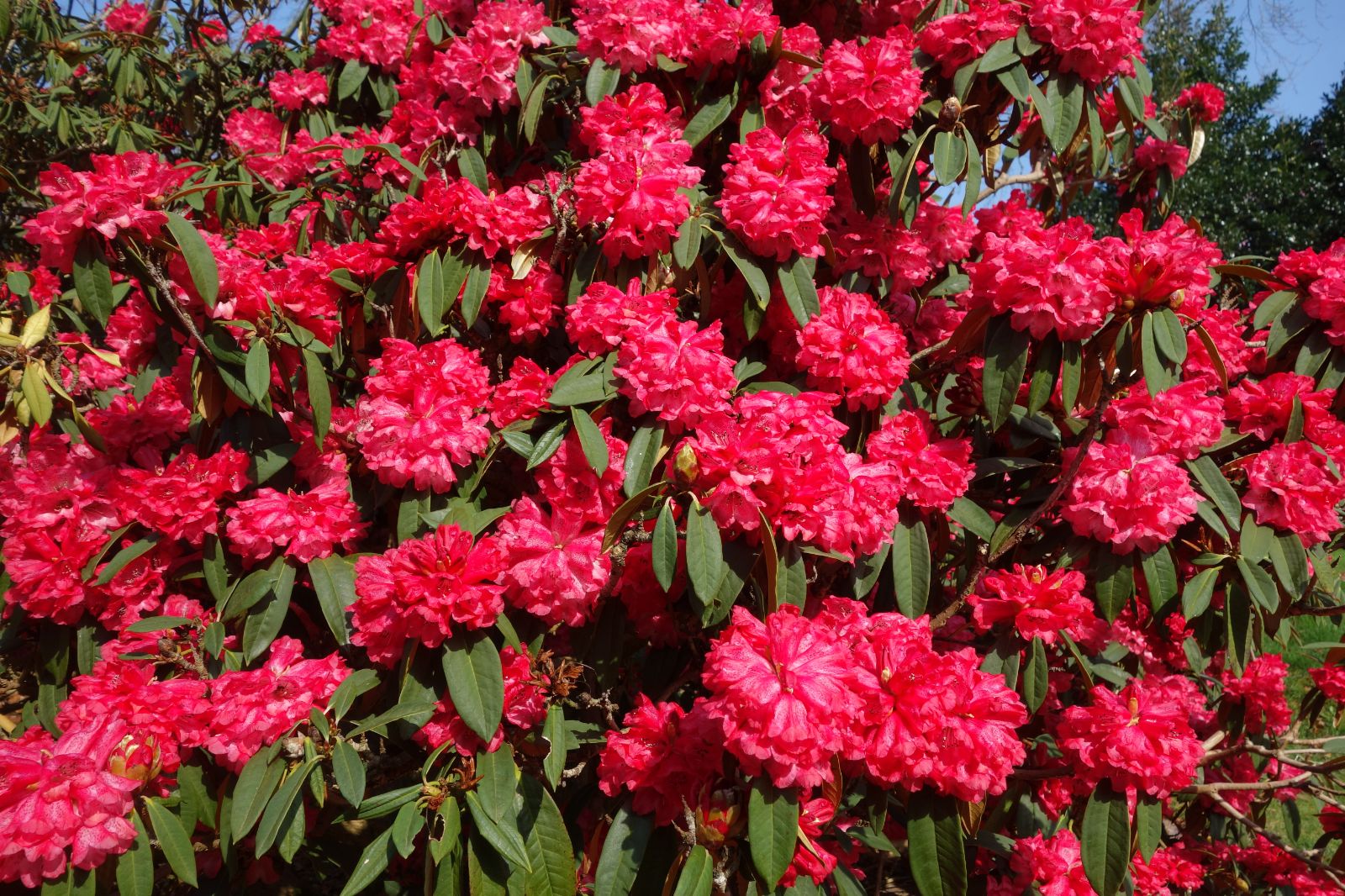Rhododendron arboreum
Sponsor
Kindly sponsored by
Peter Norris, enabling the use of The Rhododendron Handbook 1998
Credits
Article from Bean's Trees and Shrubs Hardy in the British Isles
Recommended citation
'Rhododendron arboreum' from the website Trees and Shrubs Online (treesandshrubsonline.
Genus
- Rhododendron
- Subsect. Arborea
Synonyms
- Rhododendron windsorii Nutt.
- Rhododendron arboreum subsp. windsorii (Nutt.) Tagg
Infraspecifics
Other taxa in genus
- Menziesia multiflora
- Rhododendron aberconwayi
- Rhododendron acuminatum
- Rhododendron adenogynum
- Rhododendron adenopodum
- Rhododendron adenosum
- Rhododendron aequabile
- Rhododendron afghanicum
- Rhododendron aganniphum
- Rhododendron agastum
- Rhododendron × agastum
- Rhododendron alabamense
- Rhododendron albertsenianum
- Rhododendron albiflorum
- Rhododendron albrechtii
- Rhododendron album
- Rhododendron alticolum
- Rhododendron alutaceum
- Rhododendron amagianum
- Rhododendron ambiguum
- Rhododendron amesiae
- Rhododendron anagalliflorum
- Rhododendron annae
- Rhododendron anthopogon
- Rhododendron anthopogonoides
- Rhododendron anthosphaerum
- Rhododendron anwheiense
- Rhododendron aperantum
- Rhododendron araiophyllum
- Rhododendron arborescens
- Rhododendron arfakianum
- Rhododendron argipeplum
- Rhododendron argyrophyllum
- Rhododendron arizelum
- Rhododendron armitii
- Rhododendron atlanticum
- Rhododendron atropurpureum
- Rhododendron atrovirens
- Rhododendron augustinii
- Rhododendron aureum
- Rhododendron auriculatum
- Rhododendron aurigeranum
- Rhododendron auritum
- Rhododendron austrinum
- Rhododendron baenitzianum
- Rhododendron bagobonum
- Rhododendron baileyi
- Rhododendron bainbridgeanum
- Rhododendron balangense
- Rhododendron balfourianum
- Rhododendron barbatum
- Rhododendron basilicum
- Rhododendron batemanii
- Rhododendron bathyphyllum
- Rhododendron beanianum
- Rhododendron beesianum
- Rhododendron beyerinckianum
- Rhododendron bhutanense
- Rhododendron blackii
- Rhododendron boothii
- Rhododendron brachyanthum
- Rhododendron brachycarpum
- Rhododendron bracteatum
- Rhododendron brevistylum
- Rhododendron brookeanum
- Rhododendron bryophilum
- Rhododendron bureavii
- Rhododendron bureavioides
- Rhododendron burmanicum
- Rhododendron burttii
- Rhododendron buxifolium
- Rhododendron caesium
- Rhododendron calendulaceum
- Rhododendron caliginis
- Rhododendron callimorphum
- Rhododendron calophytum
- Rhododendron calostrotum
- Rhododendron caloxanthum
- Rhododendron calvescens
- Rhododendron camelliiflorum
- Rhododendron campanulatum
- Rhododendron campylocarpum
- Rhododendron campylogynum
- Rhododendron camtschaticum
- Rhododendron canadense
- Rhododendron x candelabrum
- Rhododendron canescens
- Rhododendron capitatum
- Rhododendron carneum
- Rhododendron carolinianum
- Rhododendron carrii
- Rhododendron carringtoniae
- Rhododendron catacosmum
- Rhododendron catawbiense
- Rhododendron caucasicum
- Rhododendron cephalanthum
- Rhododendron cerasinum
- Rhododendron chaetomallum
- Rhododendron chamaethomsonii
- Rhododendron championiae
- Rhododendron charitopes
- Rhododendron chionanthum
- Rhododendron chlorops
- Rhododendron christi
- Rhododendron christianae
- Rhododendron chryseum
- Rhododendron chrysodoron
- Rhododendron ciliatum
- Rhododendron ciliicalyx
- Rhododendron cinnabarinum
- Rhododendron citriniflorum
- Rhododendron clementinae
- Rhododendron coelicum
- Rhododendron coeloneuron
- Rhododendron collettianum
- Rhododendron columbianum
- Rhododendron commonae
- Rhododendron complexum
- Rhododendron concinnum
- Rhododendron coriaceum
- Rhododendron coryanum
- Rhododendron cowanianum
- Rhododendron coxianum
- Rhododendron crassifolium
- Rhododendron crassum
- Rhododendron crinigerum
- Rhododendron cruttwellii
- Rhododendron cuffeanum
- Rhododendron culminicolum
- Rhododendron cumberlandense
- Rhododendron cuneatum
- Rhododendron cyanocarpum
- Rhododendron dalhousiae
- Rhododendron dasypetalum
- Rhododendron dauricum
- Rhododendron davidii
- Rhododendron davidsonianum
- Rhododendron decandrum
- Rhododendron × decipiens
- Rhododendron decorum
- Rhododendron degronianum
- Rhododendron dendricola
- Rhododendron dendrocharis
- Rhododendron denudatum
- Rhododendron desquamatum
- Rhododendron detonsum
- Rhododendron dianthosmum
- Rhododendron diaprepes
- Rhododendron dichroanthum
- Rhododendron dielsianum
- Rhododendron dignabile
- Rhododendron dilatatum
- Rhododendron dimitrium
- Rhododendron diphrocalyx
- Rhododendron discolor
- Rhododendron dryophyllum
- Rhododendron eclecteum
- Rhododendron × edgarianum
- Rhododendron edgeworthii
- Rhododendron elegantulum
- Rhododendron elliottii
- Rhododendron ericoides
- Rhododendron eriocarpum
- Rhododendron eriogynum
- Rhododendron erosum
- Rhododendron × erythrocalyx
- Rhododendron esetulosum
- Rhododendron eudoxum
- Rhododendron eurysiphon
- Rhododendron exasperatum
- Rhododendron excellens
- Rhododendron faberi
- Rhododendron facetum
- Rhododendron falconeri
- Rhododendron fallacinum
- Rhododendron fargesii
- Rhododendron farrerae
- Rhododendron fastigiatum
- Rhododendron faucium
- Rhododendron ferrugineum
- Rhododendron fictolacteum
- Rhododendron flammeum
- Rhododendron flavidum
- Rhododendron fletcherianum
- Rhododendron flinckii
- Rhododendron floccigerum
- Rhododendron floribundum
- Rhododendron flumineum
- Rhododendron formosanum
- Rhododendron formosum
- Rhododendron forrestii
- Rhododendron fortunei
- Rhododendron fragariiflorum
- Rhododendron fulgens
- Rhododendron fulvastrum
- Rhododendron fulvum
- Rhododendron galactinum
- Rhododendron gardenia
- Rhododendron genestierianum
- Rhododendron giulianettii
- Rhododendron glanduliferum
- Rhododendron glaucophyllum
- Rhododendron glischroides
- Rhododendron glischrum
- Rhododendron goodenoughii
- Rhododendron goreri
- Rhododendron gracilentum
- Rhododendron grande
- Rhododendron griersonianum
- Rhododendron griffithianum
- Rhododendron groenlandicum
- Rhododendron grothausii
- Rhododendron gymnocarpum
- Rhododendron habrotrichum
- Rhododendron haematodes
- Rhododendron hanceanum
- Rhododendron haofui
- Rhododendron headfortianum
- Rhododendron hedyosmum
- Rhododendron heftii
- Rhododendron heliolepis
- Rhododendron hellwigii
- Rhododendron hemitrichotum
- Rhododendron hemsleyanum
- Rhododendron herzogii
- Rhododendron hidakanum
- Rhododendron × hillieri
- Rhododendron himantodes
- Rhododendron hippophaeoides
- Rhododendron hirsutum
- Rhododendron hirtipes
- Rhododendron hodgsonii
- Rhododendron hongkongense
- Rhododendron hooglandii
- Rhododendron hookeri
- Rhododendron horlickianum
- Rhododendron houlstonii
- Rhododendron huianum
- Rhododendron hunnewellianum
- Rhododendron hyacinthosmum
- Rhododendron hylaeum
- Rhododendron hyperythrum
- Rhododendron hypoleucum
- Rhododendron imberbe
- Rhododendron impeditum
- Rhododendron imperator
- Rhododendron inconspicuum
- Rhododendron indicum
- Rhododendron inopinum
- Rhododendron insigne
- Rhododendron intranervatum
- Rhododendron intricatum
- Rhododendron irroratum
- Rhododendron japonicum
- Rhododendron jasminiflorum
- Rhododendron javanicum
- Rhododendron johnstoneanum
- Rhododendron kaempferi
- Rhododendron kanehirae
- Rhododendron kawakamii
- Rhododendron keiskei
- Rhododendron keleticum
- Rhododendron kendrickii
- Rhododendron kesangiae
- Rhododendron keysii
- Rhododendron kiusianum
- Rhododendron kiyosumense
- Rhododendron kongboense
- Rhododendron konori
- Rhododendron kyawii
- Rhododendron lacteum
- Rhododendron laetum
- Rhododendron lagopus
- Rhododendron lanatoides
- Rhododendron lanatum
- Rhododendron lanceolatum
- Rhododendron lanigerum
- Rhododendron lapponicum
- Rhododendron latoucheae
- Rhododendron laudandum
- Rhododendron lepidostylum
- Rhododendron lepidotum
- Rhododendron leptanthum
- Rhododendron leptocarpum
- Rhododendron leptothrium
- Rhododendron leucaspis
- Rhododendron leucogigas
- Rhododendron levinei
- Rhododendron lindaueanum
- Rhododendron lindleyi
- Rhododendron lochiae
- Rhododendron longesquamatum
- Rhododendron longiflorum
- Rhododendron longipes
- Rhododendron longistylum
- Rhododendron loranthiflorum
- Rhododendron lowii
- Rhododendron lowndesii
- Rhododendron luciferum
- Rhododendron ludlowii
- Rhododendron ludwigianum
- Rhododendron lukiangense
- Rhododendron luraluense
- Rhododendron luteiflorum
- Rhododendron lutescens
- Rhododendron luteum
- Rhododendron lyi
- Rhododendron lysolepis
- Rhododendron macabeanum
- Rhododendron macgregoriae
- Rhododendron macrophyllum
- Rhododendron macrosepalum
- Rhododendron maculiferum
- Rhododendron maddenii
- Rhododendron magnificum
- Rhododendron maius
- Rhododendron makinoi
- Rhododendron malayanum
- Rhododendron mallotum
- Rhododendron mariesii
- Rhododendron martinianum
- Rhododendron maximum
- Rhododendron maybarae
- Rhododendron meddianum
- Rhododendron megacalyx
- Rhododendron megeratum
- Rhododendron mekongense
- Rhododendron micranthum
- Rhododendron microgynum
- Rhododendron micromalayanum
- Rhododendron microphyton
- Rhododendron mimetes
- Rhododendron minus
- Rhododendron molle
- Rhododendron mollicomum
- Rhododendron mollyanum
- Rhododendron monosematum
- Rhododendron montroseanum
- Rhododendron morii
- Rhododendron moulmainense
- Rhododendron moupinense
- Rhododendron mucronatum
- Rhododendron mucronulatum
- Rhododendron multicolor
- Rhododendron multinervium
- Rhododendron myrtifolium
- Rhododendron nakaharae
- Rhododendron nakotiltum
- Rhododendron neoglandulosum
- Rhododendron neriiflorum
- Rhododendron nervulosum
- Rhododendron nigroglandulosum
- Rhododendron nipponicum
- Rhododendron nitidulum
- Rhododendron nivale
- Rhododendron niveum
- Rhododendron noriakianum
- Rhododendron notiale
- Rhododendron nudipes
- Rhododendron nuttallii
- Rhododendron oblongifolium
- Rhododendron obtusum
- Rhododendron occidentale
- Rhododendron ochraceum
- Rhododendron oldhamii
- Rhododendron orbiculare
- Rhododendron orbiculatum
- Rhododendron oreodoxa
- Rhododendron oreotrephes
- Rhododendron orthocladum
- Rhododendron ovatum
- Rhododendron pachypodum
- Rhododendron pachysanthum
- Rhododendron pachytrichum
- Rhododendron papillatum
- Rhododendron paradoxum
- Rhododendron parmulatum
- Rhododendron parryae
- Rhododendron parvifolium
- Rhododendron pauciflorum
- Rhododendron pemakoense
- Rhododendron pendulum
- Rhododendron pentaphyllum
- Rhododendron perakense
- Rhododendron peregrinum
- Rhododendron periclymenoides
- Rhododendron phaeochitum
- Rhododendron phaeochrysum
- Rhododendron piercei
- Rhododendron pingianum
- Rhododendron × planecostatum
- Rhododendron planetum
- Rhododendron pleianthum
- Rhododendron pleistanthum
- Rhododendron pocophorum
- Rhododendron poluninii
- Rhododendron polyanthemum
- Rhododendron polycladum
- Rhododendron polylepis
- Rhododendron ponticum
- Rhododendron praestans
- Rhododendron praeteritum
- Rhododendron praetervisum
- Rhododendron praevernum
- Rhododendron prattii
- Rhododendron preptum
- Rhododendron primuliflorum
- Rhododendron principis
- Rhododendron prinophyllum
- Rhododendron pronum
- Rhododendron proteoides
- Rhododendron protistum
- Rhododendron pruniflorum
- Rhododendron prunifolium
- Rhododendron przewalskii
- Rhododendron pseudochrysanthum
- Rhododendron pubescens
- Rhododendron pudorosum
- Rhododendron pulchrum
- Rhododendron pumilum
- Rhododendron purdomii
- Rhododendron purpureiflorum
- Rhododendron quadrasianum
- Rhododendron quinquefolium
- Rhododendron racemosum
- Rhododendron ramsdenianum
- Rhododendron rarilepidotum
- Rhododendron rarum
- Rhododendron recurvoides
- Rhododendron reticulatum
- Rhododendron retivenium
- Rhododendron retusum
- Rhododendron rex
- Rhododendron rhodoleucum
- Rhododendron rigidum
- Rhododendron ripense
- Rhododendron ririei
- Rhododendron robinsonii
- Rhododendron roseatum
- Rhododendron rothschildii
- Rhododendron roxieanum
- Rhododendron rubiginosum
- Rhododendron rubineiflorum
- Rhododendron rubropilosum
- Rhododendron rufum
- Rhododendron rugosum
- Rhododendron rupicola
- Rhododendron russatum
- Rhododendron saisiuense
- Rhododendron saluenense
- Rhododendron sanctum
- Rhododendron sanguineum
- Rhododendron santapaui
- Rhododendron sargentianum
- Rhododendron saxicolum
- Rhododendron saxifragoides
- Rhododendron sayeri
- Rhododendron scabridibracteum
- Rhododendron scabrifolium
- Rhododendron scabrum
- Rhododendron schlippenbachii
- Rhododendron schoddei
- Rhododendron scintillans
- Rhododendron scopulorum
- Rhododendron searleanum
- Rhododendron searsiae
- Rhododendron seinghkuense
- Rhododendron selense
- Rhododendron semibarbatum
- Rhododendron semnoides
- Rhododendron serotinum
- Rhododendron serpyllifolium
- Rhododendron sessilifolium
- Rhododendron setosum
- Rhododendron × sheilae
- Rhododendron shepherdii
- Rhododendron sherriffii
- Rhododendron shweliense
- Rhododendron sidereum
- Rhododendron siderophyllum
- Rhododendron sikangense
- Rhododendron simiarum
- Rhododendron simsii
- Rhododendron sinofalconeri
- Rhododendron sinogrande
- Rhododendron smirnowii
- Rhododendron × sochadzeae
- Rhododendron solitarium
- Rhododendron sororium
- Rhododendron souliei
- Rhododendron sperabile
- Rhododendron sperabiloides
- Rhododendron sphaeroblastum
- Rhododendron spiciferum
- Rhododendron spilotum
- Rhododendron spinuliferum
- Rhododendron stamineum
- Rhododendron stapfianum
- Rhododendron stenopetalum
- Rhododendron stenophyllum
- Rhododendron stevensianum
- Rhododendron stewartianum
- Rhododendron strigillosum
- Rhododendron suaveolens
- Rhododendron subansiriense
- Rhododendron subsessile
- Rhododendron succothii
- Rhododendron sulfureum
- Rhododendron sumatranum
- Rhododendron superbum
- Rhododendron sutchuenense
- Rhododendron taggianum
- Rhododendron taliense
- Rhododendron tanastylum
- Rhododendron tapetiforme
- Rhododendron tashiroi
- Rhododendron tatsienense
- Rhododendron telmateium
- Rhododendron temenium
- Rhododendron tephropeplum
- Rhododendron thayerianum
- Rhododendron thomsonii
- Rhododendron thymifolium
- Rhododendron tolmachevii
- Rhododendron tomentosum
- Rhododendron tosaense
- Rhododendron traillianum
- Rhododendron trichanthum
- Rhododendron trichocladum
- Rhododendron trichostomum
- Rhododendron triflorum
- Rhododendron tsariense
- Rhododendron tschonoskii
- Rhododendron tschonoskyi
- Rhododendron tsusiophyllum
- Rhododendron tuba
- Rhododendron ungernii
- Rhododendron uniflorum
- Rhododendron uvariifolium
- Rhododendron vaccinioides
- Rhododendron valentinianum
- Rhododendron vaseyi
- Rhododendron veitchianum
- Rhododendron venator
- Rhododendron vernicosum
- Rhododendron verruculosum
- Rhododendron versteegii
- Rhododendron vesiculiferum
- Rhododendron vialii
- Rhododendron vilmorinianum
- Rhododendron virgatum
- Rhododendron viridescens
- Rhododendron viscidifolium
- Rhododendron viscosum
- Rhododendron vitis-idaea
- Rhododendron wadanum
- Rhododendron wallichii
- Rhododendron walongense
- Rhododendron wardii
- Rhododendron wasonii
- Rhododendron watsonii
- Rhododendron websterianum
- Rhododendron weyrichii
- Rhododendron wightii
- Rhododendron williamsianum
- Rhododendron williamsii
- Rhododendron wilsoniae
- Rhododendron wiltonii
- Rhododendron womersleyi
- Rhododendron wongii
- Rhododendron wrightianum
- Rhododendron xanthocodon
- Rhododendron xanthostephanum
- Rhododendron yakushimanum
- Rhododendron yedoense
- Rhododendron yelliotii
- Rhododendron yongii
- Rhododendron yungningense
- Rhododendron yunnanense
- Rhododendron zaleucum
- Rhododendron zeylanicum
- Rhododendron zoelleri
Small to large trees, 5–30 m, with a well-defined trunk. Leaves leathery, 6.5–19 × 1.8–6 cm, narrowly to broadly elliptic or ovate, upper surface with more or less deeply impressed veins, lower surface with a compacted to dense and spongy white to fawn indumentum composed of dendroid hairs, occasionally also with a loose floccose rufous upper layer. Flowers 10–20, in a dense truss, white or pink to deep crimson-red, with dark purple flecks and nectar pouches, fleshy, tubular-campanulate, 30–50 mm. Royal Horticultural Society (1997).
RHS Hardiness Rating H3
Conservation status Least concern (LC)
Taxonomic note This is one of the most widespread and variable species of Rhododendron. Royal Horticultural Society (1997)
R. arboreum attains in the wild a height of 40 ft or more and may be narrow and erect with a single stem or many-branched from the base and more spreading girths up to 15 ft at the base have been recorded. Leaves stiffly leathery, oblong-lanceolate to oblong-oblanceolate, 4 to 8 in. long, 11⁄4 to 21⁄4 in. wide, obtuse to subacute at the apex narrowed gradually or more abruptly to the base, dark green and, when mature, glabrous above, clad beneath with, in the typical state, a close indumentum composed of rosulate hairs, but in other forms, where an upper layer of dendroid hairs is present, it may be thicker and more woolly or spongy; typically it is silvery white, but more commonly brown; lateral veins about twenty on each side, they and the minor reticulations prominent, but often obscured by the indumentum; petiole 1⁄2 to 3⁄4 in. long (rarely longer). Inflorescence a dense corymb of about twenty flowers on a rachis up to about 1 in. long, borne normally in March or April; pedicels very short, about 3⁄8 in. long, downy or glandular or both. Calyx very small, with the same covering as the pedicels; lobes broadly triangular. Corolla tubular-campanulate, 13⁄4 to 2 in. long and wide, blood-red in the typical form, with darker markings on the usually indented lobes and nectar-pouches at the base. Stamens ten, glabrous. Ovary conoid, downy and often glandular also, ten-chambered. (s. and ss. Arboreum)
R. arboreum, in its typical state, appears to be confined to the Himalaya, though in slightly different forms it extends farther to the east and south. The first account of it was published in 1799 by Capt. Thomas Hardwicke, who had seen it flowering three years earlier in Kumaon, south-east of Dehra Dun. It was first formally described and named in 1804 by James Smith, using Hardwicke’s notes and drawings, and introduced to cultivation some ten years later (see further below). In the Himalaya it ranges as far west as Kashmir, where it is found only on the outer and rainier side of the mountains that border the Vale of Kashmir on the south, but is best known from Kumaon and the Himalaya of Nepal and Sikkim. The typical state of the species is, at least for the most part, confined to low elevations, from 5,000 to 8,500 ft. The natural vegetation at these altitudes is temperate forest, much of which has been destroyed by fire, but R. arboreum survives, even on hot, sunny, grass-clad slopes, or in secondary forest of oak or pine; whether it is capable of regenerating in such habitats is not clear. At higher elevations, at least in the Nepal and Sikkim Himalaya, it gives way to the following variants, usually treated as subspecies:
subsp. campbelliae (Hook, f.) Tagg R. arboreum var. roseum Lindl.; R. album Sw.; R. campbelliae Hook, f.; R. arboreum var. campbelliae (Hook, f.) Hook. f. – In typical R. arboreum the indumentum is a thin silvery felt that covers the lateral veins and minor reticulations but, these being prominent, does not actually obscure them; also the flowers are blood-red, or at least commonly so. But at altitudes above 8,000 ft the prevailing form has a thicker, usually brown indumentum and the flowers are crimson, pink, or white, sometimes pink at the edge and white at the centre. There appears to be no constant difference in shape of leaf. The altitudinal overlap between typical R. arboreum and this subspecies is considerable and the correlation between flower-colour and indumentum is far from perfect, but it remains true that the richest coloured forms do not occur much above 8,000 ft and that there is a tendency for the indumentum to become thicker and darker with altitude.
subsp. cinnamomeum (Wall. Cat.) Tagg R. cinnamomeum Wall, ex Lindl. – This resembles the subsp. campbelliae but the leaf-indumentum is cinnamon-coloured or rusty and sometimes rather loosely woolly. The flowers are typically white, with coarse spotting, but can be pink or crimson. It is apparently confined to high altitudes and its distribution outside Nepal, whence it first became known, is uncertain.
Outside the Himalaya, R. arboreum extends across the Brahmaputra into Burma and south through the Khasi Hills and other hills of Assam, Nagaland and Manipur to Mount Victoria in eastern Burma (Arakan). But the plants in these areas are mostly untypical: the indumentum is often composed of rather long, interwoven hairs and is honeycombed with holes (alveolar); the leaves are relatively short and broad in some forms from Manipur and the Khasi Hills and in some respects recall R. nilagiricum and R. zeylanicum. It is also interesting that in these eastern and southern forms the richly coloured flowers of typical R. arboreum are sometimes combined with an indumentum of the type characteristic of subsp. campbelliae. However, these variations are of no importance horticulturally. A very distinct form was introduced by Bailey and Morshead in 1914 from the Nyamjang Chu on the border between Bhutan and Assam and was named R. morsheadianum by Millais; it was reintroduced by Kingdon Ward from the same area ten years later (KW 6403). The leaves have a very close, burnished indumentum resembling that of R. insigne and straight, deeply impressed lateral veins.
The first recorded flowering of R. arboreum in cultivation was of the typical form and took place at The Grange, Alresford, Hants, in 1826. When the seed was introduced and by whom is not known, but a possible source is Francis Buchanan Hamilton, who made important botanical collections in India and is known to have sent seeds of R. arboreum to the Calcutta Botanic Garden in 1810 from near the borders of Nepal (where he had discovered the white-flowered form of the species during a visit in 1802–3). It is also recorded that he sent seeds of a red- and a white-flowered form to the Edinburgh Botanic Garden in 1820. Neither date agrees well with a first flowering in 1826, the first being too early and the latter too late. Another possibility is that the seeds were collected during the military expedition to Nepal in 1814–16, and is borne out by the date of introduction given by Loudon – 1817 (Prain and Bean, Rhod. Soc. Notes Vol. I, pp. 175–9; Cowan, R.Y.B.1953, pp. 38–9). Three years after the conclusion of peace with Nepal, Dr Nathaniel Wallich arrived in Katmandu and sent seeds to Britain in 1820 of the subsp. campbelliae and cinnamomeum, which were widely distributed. The rose-coloured form, sown in 1821, flowered at Knight’s nursery, Chelsea, in 1828 and was named R. arboreum var. roseum by Lindley; the first recorded flowering of the white form of subsp. campbelliae was in a garden at Chester, and of the subsp. cinnamomeum at Rollisson’s nursery, Tooting, in 1836.
Both typical R. arboreum and the subsp. campbelliae were reintroduced by Hooker in 1849–50 from the interior of Sikkim, the former from near Chungthang (Hooker’s ‘Choongtam’), at the confluence of the Lachen and Lachung rivers, and both it and the subsp. campbelliae from the Laghep valley, an eastern feeder of the Tista (Himalayan Journals, Vol. II, pp. 186, 197). The oldest extant specimens in the British Isles are probably from these seed-collections. Those at Stonefield in Argyll are remnants of the plantings made by John Campbell, a friend of the elder Hooker and a relative of Dr Campbell, the Political Resident at Darjeeling, who did more than anyone to make the younger Hooker’s Sikkim expedition a success (the subsp. campbelliae, originally described as a species, is named after his wife). The famous colony of R. arboreum at Lochinch in Wigtownshire, in which pink and white forms predominate, was planted by the 10th Earl of Stair in the early 1860s, and is also from the Hooker seed.
The typical state of the species, usually distinguished in gardens as ‘blood-red arboreum’, is not reliably hardy outside the milder parts, and is by no means common even there. South of London the best-coloured forms, though they may survive quite severe winters once established, are often cut by spring frost and rarely attain a good size. The Tregothnan form, raised from seeds collected in the Himalaya by a former Viscount Falmouth, was tried at Exbury by Lionel de Rothschild and found to be hardier there than other blood-red forms.
The subsp. campbelliae is much hardier, but, like all forms of R. arboreum it flowers dangerously early and does not reveal its full beauty until twenty or so years old. Typically the flowers are pink, but both in the wild and in cultivation they may be white at the centre and pink at the edge, or wholly white except for the spotting. Many seedlings were raised by the Cornish nurseryman Gill, either from plants at Tremough (the oldest of which were from the Hooker seed) or from seed collected in the Himalaya, and some of these he propagated and named, such as ‘Blushing Beauty’, with white, pink-tinted flowers, and ‘Mrs Henry Shilson’, a fine pink with larger flowers, fewer in the truss, than normal, and almost certainly a hybrid.
The subsp. cinnamomeum is also hardy, but slow-growing and usually more bushy than the subsp. campbelliae.
The following clones of R. arboreum have received awards: ‘Goat Fell’, from Brodick Castle Gardens, Isle of Arran, A.M. May 5, 1964; ‘Rubaiyat’, from Exbury, A.M. April 2, 1968 (both these of the blood-red type); R. arboreum ‘Tony Schilling’, from Wakehurst Place, Sussex, F.C.C. April 2, 1974 (a form of subsp. campbelliae).
From the Supplement (Vol. V)
Dr Chamberlain’s treatment of this species is as follows:
subsp. arboreum – The typical state of the species, with an eastern limit in Bhutan.
subsp. cinnamomeum (Lindl.) Tagg – This is subdivided into two varieties:
var. cinnamomeum – This is described on pages 597–8. It has a local distribution, from east Nepal to Sikkim. In this is included Tagg’s subsp. campbelliae, mentioned on page 597. The leading characters are leaves shorter than in typical R. arboreum (to about 41⁄2 in. long) with a two-layered indumentum, the lower layer close as in typical R. arboreum, whitish to fawn, the upper layer rust-coloured, loose and woolly.
var. roseum Lindl. – Agreeing with var. cinnamomeum in having leaves shorter than in the typical state of R. arboreum, but differing in their having a one-layered indumentum (i.e., like that of typical R. arboreum), which is usually fawn-coloured or whitish. This ranges farther to the east than subsp. arboreum, from east Nepal to south-east Tibet, and occurs at higher altitudes. It is not at all clear what justification there is for placing this variant under subsp. cinnamomifolium rather than under subsp. arboreum, in which Tagg included it without distinction.
subsp. delavayi (Franch.) Chamberlain R. delavayi Franch. – See page 599. As pointed out there, this rhododendron extends into the eastern Himalaya. R. peramoenum, mentioned on page 600, becomes a variety of subsp. delavayi.
The subsp. delavayi was reintroduced in 1981 by the Sino-British Expedition to Cangshan (the Tali range) of Yunnan, during which a natural hybrid between it and R. decorum was also found. Another interesting reintroduction is KW 21796. from Mount Victoria in Burma (1956).
subsp. nilagiricum (Zenker) Tagg – See R. nilagiricum, page 813.
subsp. zeylanicum (Booth) Tagg – See R. zeylanicum, page 812.
For a general discussion of the variations of R. arboreum, see Rev. 2, p. 332.
R delavayi Franch.
Synonyms
R. pilovittatum Balf. f. & Forr
This species was described from specimens collected in Yunnan, China, by the French missionary Delavay, and as usually understood it is a native of that province and of parts of Burma, Thailand, and the former Indo-china. How it differs from R. arboreum has never been made clear. H. F. Tagg, in The Species of Rhododendron, p. 17, says: ‘The best distinguishing feature is in the indumentum; in R. arboreum it is usually thin and more or less plastered, whereas in R. delavayi it is of a somewhat spongy texture, the surface more or less fissured.’ This is not much to base a species upon and is not even reliable. Some specimens in the Kew Herbarium, collected by Delavay and others in Yunnan, have an indumentum differing in no way from that of R. arboreum, though the leaves tend to be shorter than in that species. Other specimens from Yunnan have the ‘spongy’ type of indumentum, but this is also to be seen on some specimens from the eastern Himalaya and the Khasi Hills (and in R. nilagiricum and R. zeylanicum).Delavay discovered this rhododendron in 1884; it was introduced to France at about the same time and thence to Kew in 1889. The first flowers seen in the British Isles were borne on a plant at Kilmacurragh, Co. Wicklow, in 1904. It was later reintroduced by Forrest from various parts of Yunnan, where it extends as far to the north-east as the Lichiang range and into the southern parts of the province. Like R. arboreum, it occurs in drier habitats than most rhododendrons, and according to Forrest is at its best on the margins of pine forests.R. delavayi is uncommon in cultivation and tender in its best forms, which are mostly to be found in Scottish collections (Lochinch, Brodick, and Crarae). It has reached 10 ft in height at Wakehurst Place in Sussex. Bot. Mag., t. 8137.
subsp. albomentosum (Davidian) D.F.Chamb.
Synonyms
R. delavayi Franch. var. albomentosum Davidian
Leaves 4–6 × 2–2.5cm, with a white spongy indumentum beneath, reticulate above; flowers a rich cherry red.
Distribution N Burma (Mt Victoria).
Habitat 3,000m.
RHS Hardiness H2–3.
Taxonomic note (R. delavayi Franch. var. albomentosum Davidian)
This tender subspecies, which apparently maintains its distinctive features in cultivation, is intermediate between subsp. arboreum and subsp. delavayi. It is only known in the wild from a single mountain and even then it may be distinguishable from more typical forms of R. arboreum that occur on the same mountain at lower altitudes
subsp. arboreum
Leaves 10–19 × 2.5–5cm, with a white to silvery compacted indumentum beneath, reticulate above; flowers crimson.
Season January-May.
Distribution N India (Kashmir to Sikkim), Nepal, Bhutan.
Habitat 1,850–2,550(–3,200)m.
RHS Hardiness H2–3.
This is the common subspecies across the Indo-Himalayas. In cultivation it is relatively tender.
subsp. cinnamomeum (Wall ex G.Don) Tagg
Leaves 6.5–11 × 2.2–4.5cm, with a white to cinnamon compacted indumentum beneath, sometimes also with an upper layer of rufous hairs, reticulate above; flowers white to crimson.
Season March-May.
Distribution E Nepal and China (S Tibet) to Bhutan and Arunachal Pradesh.
Habitat 2,750–3,650m.
RHS Hardiness H3–4a.
This subspecies tends to have a more easterly distribution than does subsp. arboreum, and occurs at higher elevations. It is therefore rather hardier in cultivation.
subsp. delavayi (Franch.) D.F.Chamb.
Synonyms
R. delavayi Franch.
Leaves 7–18 × 1.8–3(–4.2)cm, with a thick and spongy white to fawn indumentum beneath, reticulate above; flowers clear red to crimson.
Distribution NE India, Burma, Thailand, SW China.
Habitat 1,500–3,000m.
RHS Hardiness H2–3.
This subspecies is tender in cultivation, requiring considerable shelter. It replaces subsp. arboreum and subsp. cinnamomeum in the eastern part of the range of the species.
subsp. nilagiricum (Zenker) Tagg
Leaves 8.5–12 × 3.8–6cm, apex rounded-apiculate, lower surface with a yellowish brown spongy indumentum, upper surface with deeply impressed veins; flowers carmine.
Distribution S India.
Habitat c.2,250m.
RHS Hardiness H2–3.
This subspecies is intermediate between subsp. zeylanicum and subsp. delavayi.
subsp. zeylanicum (Booth) Tagg
Synonyms
R. zeylanicum Booth
Bark deeply fissured; leaves 8–11 × 3.5–4.5cm, apex blunt to acute, margin strongly recurved; lower surface with a spongy brownish indumentum, upper surface with deeply impressed veins, flowers carmine.
Distribution Sri Lanka.
Habitat 1,000–2,500m.
RHS Hardiness H2.
Awards AM 1964 (National Trust for Scotland, Brodick Castle Gardens) to a clone R. arboreum ‘Goat Fell’; flowers Cherry Red, with a few spots in the throat. AM 1968 (E. de Rothschild, Exbury) to a clone R. arboreum ‘Rubaiyat’; flowers red, with darker spots.
The characteristic leaves and bark will serve to identify this, the most distinctive of the subspecies of R. arboreum. It is a plant only for the mildest of British gardens.
var. peramoenum (Balf.f. & Forrest) D.F.Chamb.
Synonyms
R. peramoenum Balf.f. & Forrest
Leaves 4.5–6.5 × as long as broad. Royal Horticultural Society (1997)
Closely allied to R. delavayi, differing in the longer, relatively narrower leaves 3 to 6 in. long, up to scarcely 1 in. wide, less rugose above, and with a closer indumentum beneath. It was discovered by Forrest on the Shweli-Salween divide, Yunnan, near the frontier with Burma and was introduced by him.
var. roseum Lindl.
Leaves lacking the upper layer of loose hairs.
Awards FCC 1974 (Royal Botanic Gardens, Wakehurst) to a clone R. arboreum var. roseum ‘Tony Schilling’. AGM 1993.
White-flowered forms from the highest elevations, particularly in Nepal, have been referred to var. album Wall.

